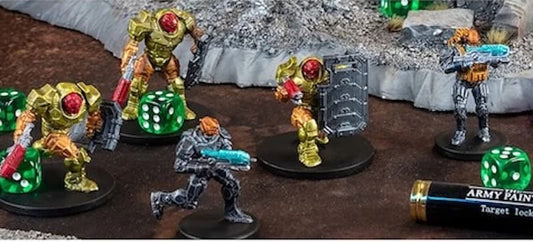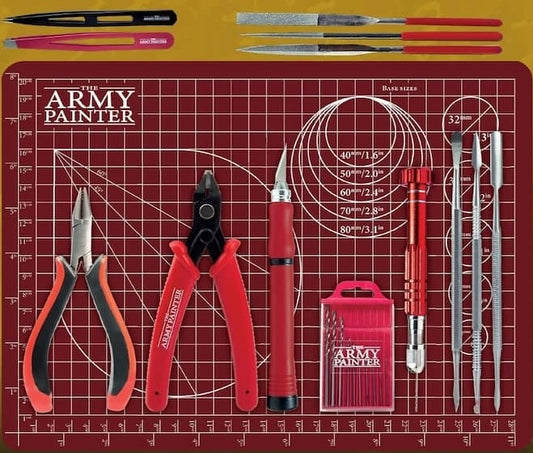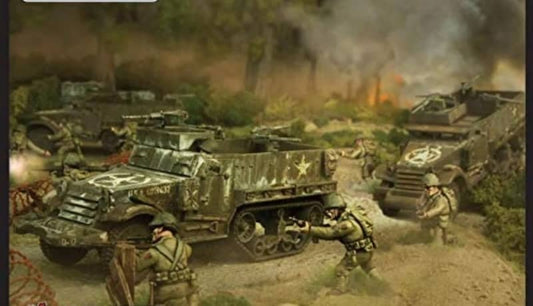Not all miniatures are created equal. Some feel light as a feather, while others could double as a paperweight. If you’ve ever prepped a Bolt Action Soviet starter army, you’ve probably encountered those pesky mold lines—tiny seams that can turn a quick hobby session into a delicate operation.
Maybe you’ve assembled a Black Seas Warlord Games frigate and thought, 'Wow, this is easier than I expected.' The truth is, the material your miniatures are made of—whether it’s resin, plastic, metal, or 3D-printed—plays a huge role in your experience. Each comes with its own quirks, from the ease of cutting plastic to the satisfying heft of metal.
But which one is right for you? Let’s explore the differences, pros, and quirks of each material so you can pick the perfect fit for your next project.
Wargaming Miniature Materials
Plastic: The New Standard
Remember those old army men toys from childhood? Modern wargaming plastic is worlds apart. Today's injection-molded plastic miniatures offer crisp detail that rivals their premium counterparts. If you've picked up anything from Warlord Games in the last decade, you've experienced this firsthand.
What makes plastic special is its user-friendly nature. Need to modify a pose or swap out weapons on your Bolt Action infantry? Your hobby knife glides through it like butter. Plus, plastic kits are generally non-toxic and extremely forgiving for beginners.
The only real catch? Those finer details on plastic kits need a bit of care during assembly and storage. But let's be honest: If you're passionate enough about historical wargaming to be reading this, you're probably already treating your miniatures with respect.
Metal: The Classic Touch
You know that moment when you first pick up a metal miniature? There's something about that weight in your hand. It takes you back to when these hefty little soldiers ruled every gaming table in sight. And while they might not dominate the market like they used to, metal minis still have their place in our hobby.
They're tough; drop one, and it's more likely to dent your floor than break. That durability comes in handy when you're fielding delicate pieces like radio antennas or rifle barrels. And there's a certain crispness to metal castings that just feels... right. Especially on those character models where every detail counts.
Mind you, working with metal isn't always smooth sailing. You'll need a different toolkit - files become your best friend when dealing with mold lines, and superglue replaces plastic cement. For bigger pieces, you might find yourself drilling and pinning parts together to make sure they stay put. Some folks love this traditional approach to the hobby, while others... well, let's just say they're happy we have modern alternatives.
Resin: Detail Meets Technology
Remember when resin was just that finicky material that came with premium kits? Times have changed. Take Warlord's new Resin Plus for instance — it's showing us what modern resin can really do. You get those crisp details like metal, but without feeling like you're lifting weights when you move your army across the table.
The technology's gotten clever too. Unlike the resins of old that would snap if you looked at them wrong, modern wargaming resin has some give to it. It's hard but flexible — think of it like a premium plastic that's been hitting the gym. And when it comes to detail? Those sculpts are sharp. You'll see it in everything from the webbing on infantry to the textures on vehicle armor.
Working with it is simple as well. Your regular hobby knife and super glue still do the job. The cleanup's usually easier than metal, and you don't need to worry about pinning every joint. Sure, you might pay a bit more than plastic, but for those special units that really need to pop on the table? Many hobbyists reckon it's worth it.
What Makes Sense for Your Army?
Most wargame miniatures end up as a mix of materials. But knowing what to choose and when can save both time and money. Here are the factors you need to consider:
Project Scale and Budget
Budget plays a big part in building any army. Plastic tends to be your friend when you're fielding multiple units. Metal and resin command higher prices, but they deliver extra detail that can elevate special units or character models to the next level.
Gaming Environment
Consider where and how you'll be gaming. If you're regularly packing up your army for club nights or tournaments, durability becomes crucial. Metal models might weigh more, but they can handle transport. Playing mostly at home? Resin's lighter weight and pristine detail could be ideal.
Model Purpose
Think about what you're trying to achieve with each unit. Standard troops look great in plastic, while that commanding officer might deserve the extra crispness that resin provides. And don't forget about conversions—plastic remains unbeatable when you want to create something unique by mixing different kits.
Assembly Requirements
Finally, there's the practical side of assembly to consider. Plastic comes together easily with plastic cement, making it perfect for beginners. Metal might need pinning for larger models, while resin works well with super glue and rewards careful preparation.
Final Verdict
Every player remembers that one unit that changed the game for them. Maybe it wasn't the most expensive kit, but something about it just worked. The same goes for materials. Don't just follow the standard plastics-for-troops formula. That metal field gun might anchor your firebase perfectly, while a resin command squad could give your army's heart the detail it deserves.
Sometimes the best forces come from putting your centerpiece first. Pick that one unit that really speaks to you—the one you're going to spend extra time painting—and build your army's story around it. The materials will fall into place naturally, and you'll end up with something that feels more like your force.
Infographic
Miniatures vary in weight and material; some are very light, while others are quite heavy. Most wargame miniatures use a mix of materials, so knowing what to choose can save you time and money. Find out in this infographic the key factors in selecting miniature materials.




